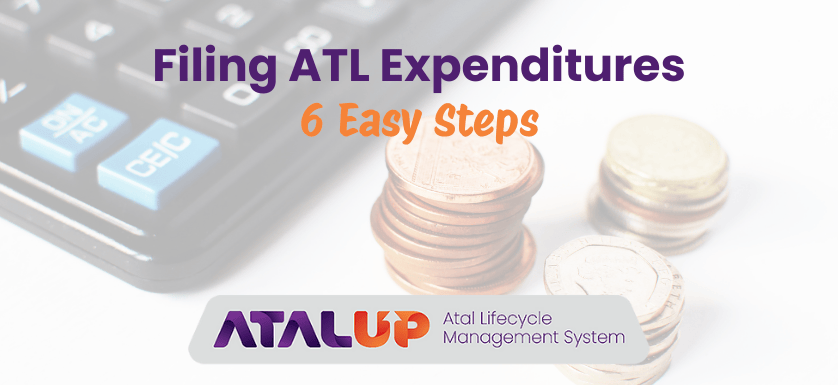
AIM has decided to grant ₹20 lakh per school for Atal Tinkering Lab. Schools receiving an ATL grant will get complete guidelines for setting up labs and executing activities. Engaging students, encouraging them to participate in other ATL competitions, and enrolling in practical learning are a few basic objectives of the Atal Innovation Mission (AIM).
Schools must understand that the grant must be spent on the welfare of students through ATL. Hence, it is mandatory to file ATL expenditures.
Filing ATL expenditures is not just a formality. It is a required process to show the Government of India how the school is using the ₹20 lakh grant. This includes both the setup cost and the yearly operational expenses.
If a school fails to file the proper reports like the Utilization Certificate (UC), Audited Statements, or PFMS entries, it may face the following problems:
- Delay in receiving future funds
- Non-compliance warnings from AIM or NITI Aayog
- Rejection from other grant schemes
- Loss of credibility in front of CSR partners and state education boards
Even if the ATL is active, without proof of usage, it may be marked “non-functional” in official records.
Filing ATL expenditures on time and in the correct way helps the school in many ways. Schools can get the next ₹2 lakh annual grant in a hassle-free manner. A systematic filing builds trust and transparency. It also shows that the ATL is a well-performing lab, ready for growth and recognition.
Managing and Filing ATL Expenditures
Managing and reporting expenditures for Atal Tinkering Lab (ATL) is important for compliance and for getting future funding. Here’s a step-by-step guide to help schools handle this process properly.
1. Understanding the ATL Funding Structure
Each ATL receives a total grant of ₹20 lakh over five years:
- ₹10 lakh as a one-time setup cost for purchasing equipment
- ₹10 lakh for Operational and Maintenance (O&M) expenses, released as ₹2 lakh every year for five years
2. Using ATL Funds as Per Guidelines
Establishment Cost (₹10 lakh):
Schools can use the setup grant to buy equipment from the official list provided by AIM and complete the procurement within the given time.
O&M Expenses (₹2 lakh annually):
Schools can use these funds for maintaining ATL equipment, buying consumables, and organising workshops, science lectures, and competitions. Schools can also use the amount to pay honorariums to teachers and mentors involved in ATL activities.
3. Maintaining Accurate Financial Records
Utilization Certificate (UC):
This document must show the funds received, the amount spent, the remaining balance, and any interest earned. The Principal must sign it, and the school’s finance officer must verify it.
Audited Statement of Accounts:
This report must show all capital and operational expenses and the unspent balances. It must be audited properly.
Interest Remittance:
If any interest is earned on the ATL grant, the school must send it to the Consolidated Fund of India. Schools must keep receipts or proof like payment confirmation from Bharatkosh or a demand draft copy.
4. Submitting Documents to Receive the Next Installment
To get the next part of the funding, the school must do the following:
- Complete the MyATL Dashboard by updating all ATL activities and expenditure details
- Upload these documents on the AIM portal:
- Utilization Certificate (UC)
- Audited Statement of Accounts
- Acknowledgment or proof of interest remittance
- PFMS-generated reports (EAT Report 02 and EAT Report 03)
- Tax Exemption Declaration (if applicable)
- Utilization Certificate (UC)
5. Registering and Reporting Through PFMS
What is PFMS?
PFMS (Public Financial Management System) is a government platform used to track how public funds are used. Every ATL school must be registered here to ensure transparency.
Why PFMS is Important for ATL Schools:
- AIM only releases grants to schools registered under PFMS
- All ATL-related transactions must be recorded on this portal
- PFMS tracks fund usage and supports future fund releases
Steps to Follow:
- Visit pfms.nic.in
- Register the school under the correct scheme head
- Update all ATL-related expenses regularly
- Generate and download:
- EAT Report 02 – showing how funds were spent
- EAT Report 03 – showing vendor/supplier payment details
These reports are necessary for submitting fund usage details to AIM.
6. Following AIM Guidelines Carefully
Why It Matters:
NITI Aayog and AIM release updated guidelines every year. Schools that do not follow them may face funding delays or disqualification from future ATL opportunities.
Where to Find Guidelines:
- AIM’s official communications
- Notifications on MyATL Dashboard
- Emails sent to the ATL in charge or school principal
Important Points to Track in Guidelines:
- What expenses are allowed or not allowed
- Formats for UC, SOA, and interest remittance
- Deadlines for submitting reports and documents
- Rules about tool usage, lab activities, and teacher responsibilities
Tip: Schools should assign a staff member to review AIM guidelines every 2–3 months and maintain a checklist of all required submissions.
Conclusion: Filing ATL Expenditures? ATALUP Can Help
Managing ATL reports, finances, and deadlines can become a difficult task, especially with school responsibilities and changing rules. ATALUP helps schools manage all of this with ease.
How ATALUP Helps:
- Tracks every rupee spent on tools, materials, events, and maintenance
- Prepares Utilization Certificates, SOA, and PFMS reports like EAT 02 and EAT 03 quickly
- Monitors tool usage and keeps inventory updated
- Sends automatic alerts to remind about submission deadlines
- Stores all financial documents safely in one place
Schools using ATALUP stay compliant, avoid delays, and focus on innovation and learning. While ATALUP takes care of the reports and backend work, the school can focus on building a better future for its students through ATL. If you want to know the steps to entire ATL compliance, click here.